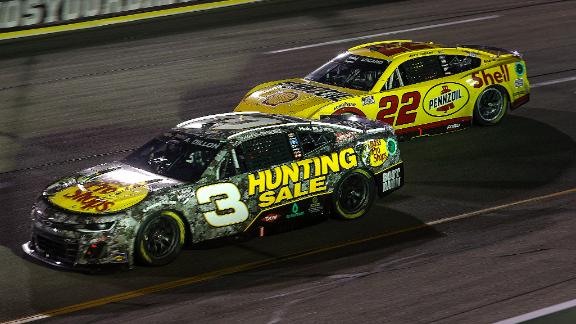
In a stunning twist at the Richmond Raceway, NASCAR fans witnessed a dramatic finale that left tongues wagging and tempers flaring. The event, initially set for 400 laps, extended to 408 after a collision involving Ricky Stenhouse Jr. and Ryan Preece on lap 398 triggered the race's only yellow flag. This incident set the stage for a riveting green-white-checkered finish—a high-stakes overtime scenario that would determine the race’s outcome.
Austin Dillon, driving for Richard Childress Racing, seemed poised for victory as he led the pack with just a few laps remaining. Dillon, who had not seen a win in two years and had only two top-10 finishes this season, had led for 34 laps on Sunday. Victory appeared imminent until the caution disrupted his lead. When the green flag waved for the final two-lap sprint, Dillon faced a formidable challenge from Joey Logano of Team Penske and Denny Hamlin from Joe Gibbs Racing.
What followed was a masterclass in racing desperation. With less than a minute to secure his win, Dillon, clearly channeling a level of competitiveness reminiscent of a hungry uncle at a family barbecue, made aggressive moves. On the final lap, Dillon first collided with Logano, spinning him around, then swiftly moved to bump Hamlin into the wall. This reckless display of driving allowed Dillon to cross the finish line first, capturing a victory that many are calling controversial.
The spectacle of Dillon’s maneuvers was both thrilling and contentious. As Dillon’s car navigated the final turns, he engaged in a brutal game of bumper cars, effectively eliminating both Logano and Hamlin from contention. The television commentator had predicted such an outcome, noting that Dillon's approach was likely to involve contact. Moreover, Dillon’s team had actively encouraged him to use such aggressive tactics to secure the win.
Richard Childress, Dillon’s grandfather and team owner, expressed pride over the radio immediately after the race, highlighting the high-stakes nature of Dillon’s victory. Although NASCAR’s rules permit such aggressive tactics, this outcome stirred significant debate. Logano, who finished 19th, expressed his frustration vehemently, calling Dillon’s actions "chickenshit" and labeling him as a "piece of crap." Hamlin, who finished second despite Dillon’s collision, echoed concerns about the sport’s regulatory standards, suggesting that NASCAR’s leniency towards such reckless driving might prompt a reevaluation of their rules.
Despite the controversy, Dillon’s win could prove pivotal for his season, potentially boosting his standing and playoff prospects. NASCAR’s senior vice president of competition, Elton Sawyer, hinted at a possible review of the incident, suggesting that while the outcome might stand, the governing body could consider setting new precedents for future races.
The dramatic end to the Richmond race not only showcased Dillon’s aggressive strategy but also highlighted ongoing debates about racing conduct and rule enforcement in NASCAR. As fans and drivers continue to weigh in, it’s clear that this race will be remembered for its thrilling yet contentious finish, where a driver’s relentless pursuit of victory turned the final laps into a dramatic showdown.




0 Comments